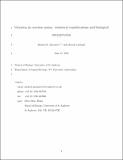Files in this item
Variation in reaction norms: statistical considerations and biological interpretation
Item metadata
| dc.contributor.author | Morrissey, Michael Blair | |
| dc.contributor.author | Liefting, Maartje | |
| dc.date.accessioned | 2017-08-21T23:32:04Z | |
| dc.date.available | 2017-08-21T23:32:04Z | |
| dc.date.issued | 2016-09-07 | |
| dc.identifier | 243626748 | |
| dc.identifier | c00b92cb-531a-4d50-a479-376965a7d59b | |
| dc.identifier | 84985906474 | |
| dc.identifier | 000383342000002 | |
| dc.identifier.citation | Morrissey , M B & Liefting , M 2016 , ' Variation in reaction norms: statistical considerations and biological interpretation ' , Evolution , vol. 70 , no. 9 , pp. 1944-1959 . https://doi.org/10.1111/evo.13003 | en |
| dc.identifier.issn | 1558-5646 | |
| dc.identifier.uri | https://hdl.handle.net/10023/11523 | |
| dc.description | M.B.M. is supported by a Royal Society (London) University Research Fellowship. M.L. is supported by the Netherlands Organisation for Scientific Research, VIDI grant nr. 864.03.003. | en |
| dc.description.abstract | Analysis of reaction norms, the functions by which the phenotype produced by a given genotype depends on the environment, is critical to studying many aspects of phenotypic evolution. Different techniques are available for quantifying different aspects of reaction norm variation. We examine what biological inferences can be drawn from some of the more readily-applicable analyses for studying reaction norms. We adopt a strongly biologically-motivated view, but draw on statistical theory to highlight strengths and drawbacks of different techniques. In particular, consideration of some formal statistical theory leads to revision of some recently, and forcefully, advocated opinions on reaction norm analysis. We clarify what simple analysis of the slope between mean phenotype in two environments can tell us about reaction norms, explore the conditions under which polynomial regression can provide robust inferences about reaction norm shape, and explore how different existing approaches may be used to draw inferences about variation in reaction norm shape. We show how mixed model-based approaches can provide more robust inferences than more commonly-used multistep statistical approaches, and derive new metrics of the relative importance of variation in reaction norm intercepts, slopes, and curvatures. | |
| dc.format.extent | 16 | |
| dc.format.extent | 355726 | |
| dc.language.iso | eng | |
| dc.relation.ispartof | Evolution | en |
| dc.subject | Phenotypic plasticity | en |
| dc.subject | Reaction norm | en |
| dc.subject | Statistics | en |
| dc.subject | QA Mathematics | en |
| dc.subject | QH301 Biology | en |
| dc.subject.lcc | QA | en |
| dc.subject.lcc | QH301 | en |
| dc.title | Variation in reaction norms: statistical considerations and biological interpretation | en |
| dc.type | Journal article | en |
| dc.contributor.sponsor | The Royal Society | en |
| dc.contributor.institution | University of St Andrews. School of Biology | en |
| dc.contributor.institution | University of St Andrews. Centre for Biological Diversity | en |
| dc.identifier.doi | 10.1111/evo.13003 | |
| dc.description.status | Peer reviewed | en |
| dc.date.embargoedUntil | 2017-08-21 | |
| dc.identifier.grantnumber | UF130398 | en |
This item appears in the following Collection(s)
Items in the St Andrews Research Repository are protected by copyright, with all rights reserved, unless otherwise indicated.

